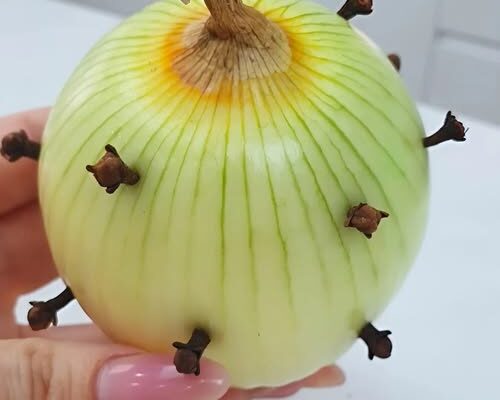My grandmother had a curious ritual in her warm, aromatic kitchen that fascinated me as a child. Before any pot touched the stove, she would take an unpeeled onion, pierce it carefully with cloves, and drop it into the pan as though performing a quiet ceremony. At the time, I didn’t understand why she did it, but I was captivated by the mingling scents that filled the air. Only years later, when I began cooking on my own, did I realize the depth of her simple yet brilliant method.
This technique, known in French cuisine as oignon piqué, is both elegant and practical. It involves inserting cloves into a whole onion—sometimes along with a bay leaf—to impart a delicate aroma and complexity to a dish. The pairing of the onion’s mellow sweetness with the clove’s spicy warmth creates a subtle harmony that enhances soups, stews, sauces, and broths without overpowering them. Unlike bold seasoning, which announces itself immediately, this infusion works quietly, layering flavor in a way that feels natural and comforting.
Cloves themselves are remarkable ingredients. These dried flower buds of the Syzygium aromaticum tree carry a powerful fragrance and contain eugenol, a natural compound responsible for their distinctive scent and slightly numbing quality. Eugenol is also known for its antibacterial and medicinal properties, which might explain why many traditional cuisines have used cloves not only for flavor but for wellness. When simmered slowly in liquid, cloves release eugenol at a measured pace, allowing their essence to mingle gracefully with other ingredients. The result is a balanced infusion that adds warmth, depth, and a faint sweetness to the final dish.
Studding an onion with cloves offers clever practicality as well. By anchoring the cloves in the onion, a cook can easily retrieve them later, ensuring no diner bites into a strong, bitter fragment by accident. This makes it easier to control the flavor intensity while still benefiting from the clove’s aromatic presence. The sight of a clove-studded onion floating in a simmering pot is charming too—a rustic emblem of care and tradition that bridges old-world techniques with everyday cooking.
Even in modern kitchens, where convenience often takes precedence over ritual, the oignon piqué remains relevant. Professional chefs and home cooks alike continue to rely on it to deepen the flavor of béchamel sauce, vegetable stock, or creamy rice dishes. In roasts and braises, it introduces a gentle warmth that elevates humble ingredients into something memorable. The method requires almost no effort, yet it transforms ordinary meals into experiences rich with aroma and character.
Whenever I prepare an oignon piqué, I think of my grandmother’s steady hands and the patience with which she cooked. Her kitchen was not just a place of nourishment but a space where care and tradition lived. The simple act of piercing an onion with cloves has become more than a culinary technique for me—it is a connection to her wisdom and love. Through that fragrant ritual, I honor her memory each time I cook, carrying her legacy forward in every simmering pot and savory broth. It is a small gesture, but one that turns the everyday act of cooking into something sacred: a celebration of memory, flavor, and the enduring bond between generations.



